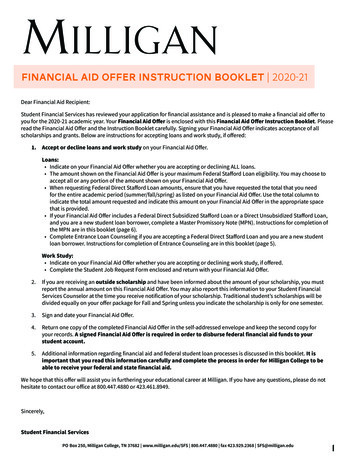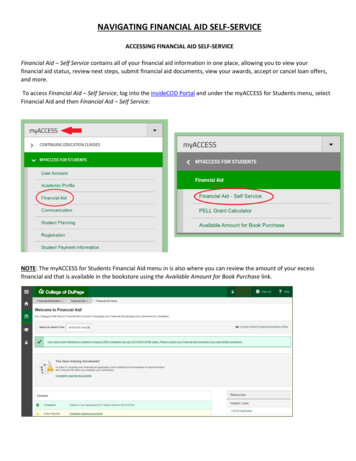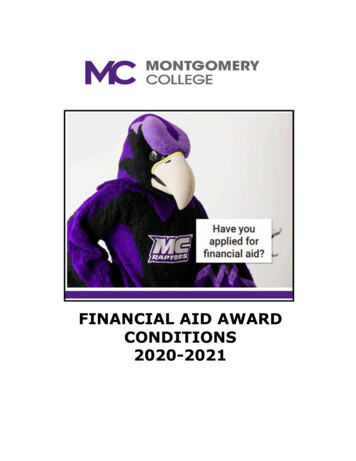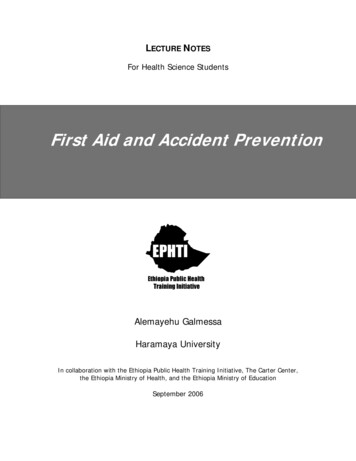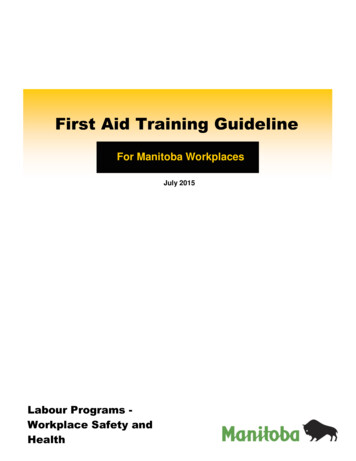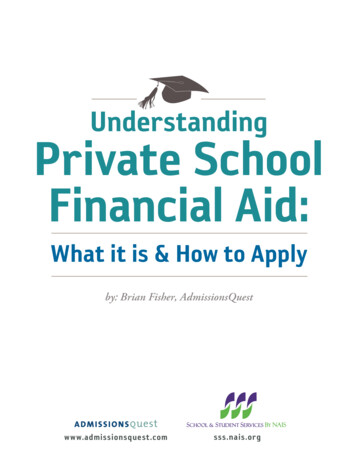
Transcription
UnderstandingPrivate SchoolFinancial Aid:What it is & How to Applyby: Brian Fisher, AdmissionsQuestUnderstandingPrivate Schoolwww.admissionsquest.comsss.nais.org
Acknowledgements:This booklet is an amalgamation of more than just our writings andthinking about the private school financial process. It is a collection ofshared thoughts and works collected over the years by our colleaguesand us. We do not stand alone as experts in the private school financialaid process. We freely admit that we stand on the shoulders of thosewho’ve come before us.AdmissionsQuest’s niche in the process is bringing thethinking surrounding financial aid as far as we can into the open.AdmissionsQuest’sniche in the process isbringing thethinking surroundingfinancial aid as far aswe can into the open.Beyond our own letters and works, this booklet draws from workspublished by School & Student Services By NAIS (SSS) and SewicklyAcademy. We believe that the best insights and understandings of thefinancial aid process come from some of the best people andorganizations in the business.Our goal for this booklet is to present the process just as we would if wewere talking to a family in the office or the coffee shop. We use “financialaid,” “financial aid process,” and “FA” interchangeably.Understanding Private School Financial Aid: What it is and How to Applyi
Table of contentsThings to know about filing for financial aid. . . . . . . . . . . . 1Case studies . . . . . . . . . . . . . . . . . . . . . . . . . . . . . . . . . . . . . . 11Eligibility. . . . . . . . . . . . . . . . . . . . . . . . . . . . . . . . . . . . . . . . 1Apply for financial aid. . . . . . . . . . . . . . . . . . . . . . . . . . . . . . 12questions and topics that you might be asking . . . . . . . . . . 1Start early . . . . . . . . . . . . . . . . . . . . . . . . . . . . . . . . . . . . . . 12Primary financial aid questions. . . . . . . . . . . . . . . . . . . . . . . 2Calendar . . . . . . . . . . . . . . . . . . . . . . . . . . . . . . . . . . . . . . . 12Deadlines. . . . . . . . . . . . . . . . . . . . . . . . . . . . . . . . . . . . . . . 12True cost of attendance . . . . . . . . . . . . . . . . . . . . . . . . . . . . . 2An ideal financial aid timeline. . . . . . . . . . . . . . . . . . . . . . . 13Honesty, openness, and accuracy . . . . . . . . . . . . . . . . . . . . . 2August-December. . . . . . . . . . . . . . . . . . . . . . . . . . . . . . . . 13The financial aid process . . . . . . . . . . . . . . . . . . . . . . . . . . . . 3Seeking financial aid. . . . . . . . . . . . . . . . . . . . . . . . . . . . . . . 3Financial aid is a finite resource . . . . . . . . . . . . . . . . . . . . . . 4Expect to pay something. . . . . . . . . . . . . . . . . . . . . . . . . . . 4Questions for the Financial Aid Director . . . . . . . . . . . . . . 13What about schools with rolling admissions? . . . . . . . . . . . 13Financial aid deadlines . . . . . . . . . . . . . . . . . . . . . . . . . . . . 14November or December . . . . . . . . . . . . . . . . . . . . . . . . . . . 15January or early February . . . . . . . . . . . . . . . . . . . . . . . . . . 15January or February. . . . . . . . . . . . . . . . . . . . . . . . . . . . . . . 15Admission and financial aid decisions are independent. . . . 4Late February or early March . . . . . . . . . . . . . . . . . . . . . . . 15Admissions and financial aid: concurrent processesbut different deadlines. . . . . . . . . . . . . . . . . . . . . . . . . . . . . 4March or April. . . . . . . . . . . . . . . . . . . . . . . . . . . . . . . . . . . 15School fit comes first . . . . . . . . . . . . . . . . . . . . . . . . . . . . . . . 5For your records. . . . . . . . . . . . . . . . . . . . . . . . . . . . . . . . . . 15Need help with school fit?. . . . . . . . . . . . . . . . . . . . . . . . . . 5April, May, June. . . . . . . . . . . . . . . . . . . . . . . . . . . . . . . . . . 15Additional resources . . . . . . . . . . . . . . . . . . . . . . . . . . . . . . . 15Educate yourself about what ‘financial aid’ means. . . . . . . . 5Talk with your school(s). . . . . . . . . . . . . . . . . . . . . . . . . . . . . 6Do NOT become angry or frustrated with the schoolor the financial aid officer working with you. . . . . . . . . . . . 6The two ways to learn if you qualify for financial aid . . . . . 6What if you’re still just not sure whether to go throughthe aid process? . . . . . . . . . . . . . . . . . . . . . . . . . . . . . . . . . . 7Third party financial aid services. . . . . . . . . . . . . . . . . . . . . 7Examples of third party financial aid processors. . . . . . . . . 7What does the financial aid processing company do?What does a school learn from myfinancial aid application?. . . . . . . . . . . . . . . . . . . . . . . . . . . 8School loans: three important thoughts. . . . . . . . . . . . . . . . 9Financial aid realities for the late applicant. . . . . . . . . . . . . 9The financial aid package. . . . . . . . . . . . . . . . . . . . . . . . . . . . 10Need-based financial aid. . . . . . . . . . . . . . . . . . . . . . . . . . . 10Merit awards. . . . . . . . . . . . . . . . . . . . . . . . . . . . . . . . . . . . 10Sibling discounts. . . . . . . . . . . . . . . . . . . . . . . . . . . . . . . . . 10Employee discounts. . . . . . . . . . . . . . . . . . . . . . . . . . . . . . . 10Payment plans. . . . . . . . . . . . . . . . . . . . . . . . . . . . . . . . . . . 10Loan programs. . . . . . . . . . . . . . . . . . . . . . . . . . . . . . . . . . . 10Understanding Private School Financial Aid: What it is and How to Applyii
Some opening thoughts on the school searchand financial aid/things you should knowabout filing for financial aidAre weeligible forfinancial aid?We begin with some thoughts that we include in almost every note wewrite to families asking about financial aid. These thoughts may comeacross as blunt; that is a conscious decision. Any healthy financial aidapplication requires a realistic understanding and acceptance of theprocess, as well as an acceptance of the potential outcomes.Eligibility: the fundamental questionThis book is for parents who are interested in securing a private schooleducation for their child and who have questions about how to makeprivate school tuition a financial reality.Here’s a quick rhetorical distillation of the questions and topics thatyou might be asking:Who canhelp us? Towhom shouldwe speak? Tuition is high. We want to afford private school, but we have limitedresources. Is our family eligible for financial aid? Are we eligible for financial aid? Are we likely to receive an FA award? Is there a way to figure out if we qualify? Who can help us? To whom should we speak? Where should we start?Placing your family in the financial aid continuum to determinewhere you stand and the likelihood of FA eligibility isn’t as difficultas you might think.Where shouldwe start?Many families mistakenly believe they will not qualify. However, nospecific income level disqualifies a family from financial aid. FA eligibilityis based on many factors. Always investigate the possibility of receivingfinancial aid if you feel you cannot pay all of the costs yourself.Understanding Private School Financial Aid: What it is and How to Apply1
Your financial aid conversation beginswith these primary financial aid questions What percentage of students receive financial aid? What is the school’s average grant? If your child receives financial aid for one year, what is the school’s policyfor renewing granted aid in subsequent years? If you are separated ordivorced, how does the school evaluate your family’s financial status andability to pay? What options exist if you don’t get the aid you need?Know howmuch it coststo attend(everythingincluded) theschool(s) towhich you’reapplying.True cost of attendance: a number you must knowOnce you know the list of schools to which you will apply, do yourfinancial homework. Ask the school about the full cost of attendance.Know how much it costs to attend (everything included) the school(s)to which you’re applying.At some schools, tuition or tuition, room, and board, includes everythingor it includes everything but books and incidentals.At other schools, tuition or tuition, room, and board covers only that withextra, required charges that will be billed later for items such as books,supplies, transportation, athletics, field trips, weekend activities, etc. Thesecharges can quickly add up to large numbers, pushing the true cost ofattendance quite a distance beyond quoted tuition numbers.Honesty, openness, and accuracyHonesty among everyone involved, openness in communication, andaccuracy in reporting are the hallmarks of a sound financial aid application.As a family, it’s paramount that you work with financial aid officers ina forthright manner. We will do the same with you, our readers. Withrealities in the daylight, we can offer the best suggestions we knowregarding school financing, scholarships, and financial aid.Understanding Private School Financial Aid: What it is and How to Apply2
The financial aid process is thorough and rigorousA successful financial aid application requires planning, attention todetail, and tenacity. Be prepared to commit your time and be ready touse a fine toothed comb as you gather your financial information andanswer questions.Don’t becomediscouraged or giveup on the financialaid process.Don’t become discouraged or give up on the financial aid process.Financial aid is a significant part of the decision to provide your child withthe best educational opportunities you can find.Be prepared to spend time and effort on all phases of the financial aid process—communicating with schools, gathering documents, and entering data.Don’t leave parts of the FA process undone until the last minute.Don’t leave partsof the FA processundone until thelast minute.Seeking financial aid is a process, not a recipeFinancial aid is a process—often with a good number of dead ends beforefinding what you need.There’s no ready money. The best approach to any process is tounderstand it, to harness it for use, to be at peace with the possibleoutcomes, and to breathe.Completing the FA process will not produce a specific result. Each schooladministers it’s own financial aid program, making awards and grantsbased on the competition for need-based financial aid. The amount of aidyou might receive varies from school to school based on how much aid theschool has available and the quality of competition for each available dollar.Financial aid isa process—oftenwith a goodnumber of deadends beforefinding whatyou need.Prepare yourself to be told “no” or to receive financial aid packages smaller thanwhat you believe you need or qualify for.Prepare yourselfto be told ‘no’or to receivefinancial aidpackages smallerthan what youbelieve you needor qualify for.Understanding Private School Financial Aid: What it is and How to Apply3
Financial aid is a finite resourceFinancial aid monies are finite and scarce. A school doesn’t want to limitthe ability of any good student to attend. However, a school must allocateits resources (financial aid dollars in this discussion) in the best way that itknows how and in accordance with its financial aid policies.Expect to pay something: private school is a partnershipbetween school and familyIn the spirit of partnership between school, student, and family, when aschool makes a financial commitment to support a student, it wants to seea similar promise from a family. This establishes a shared seriousness andcommon bond.Even if your family qualifies and receives a substantial aid package, beprepared to pay something.Admission and financial aid decisionsare independent of one another;they are not connectedYour admission application and financial aid application are twocompletely separate entities. A school’s Admission Committee knowsnothing about, and does not have access to, financial aid information.It’s perfectlypossible to beaccepted to aschool and thenreceive a financialaid package toosmall to supportmatriculation.It’s perfectly possible to be accepted to a school and then receive a financial aidpackage too small to support matriculation.Admissions and financial aid: concurrent processesbut different deadlinesAdmission deadlines can differ from school to school. Some schoolsuse a process called rolling admission, under which they make a decisionregarding an applicant’s admittance a short time after the student’sapplication is complete. Know the processes and the dates thatyour school uses.Financial aid deadlines. Know each school’s financial aid deadlines.Again, they can differ from school to school. However, they tend to bemore uniform, fall on the same date or earlier than application deadlines,and most importantly for the applying family, financial aid deadlines tendto be hard and fast.If you miss afinancial aiddeadline, youare likely tomiss out on aid.If you miss a financial aid deadline, you are likely to miss out on aid.Understanding Private School Financial Aid: What it is and How to Apply4
School fit comes first: all the financial aidin the world will be of no benefit if theschool fit isn’t goodEven though a financial aid application can take on a life of its own andbegin to overshadow the admission process, remember that the processis about your child and finding the school that will do the best job ofcultivating him or her.Your first order of business must be to seek and identify schools that best fitwhere your child stands in his or her educational path.Find the school(s)that best ‘fits’then makefinancial aid partof the applicationprocess.Find the school(s) that best ‘fits’— then make financial aid part of theapplication process.Need help with school fit?You can find our resources covering school fit at www.admissionsquest.com.Educate yourself about what ‘financial aid’means: what are we talking about when weuse the term financial aid?We’re often talking about a combination of different types of aid: needbased merit scholarships, grants, and loans combined into a single packagethat can make school tuition affordable for a given family.Financial aid isnot simply a grantor a lower tuitionnumber awardedby a school.Financial aid is not simply a grant or a lower tuition numberawarded by a school.A family’s financial aid package is exactly that—a series of differentsolutions in the form of grants, loans, or maybe a tuition paymentplan—woven together to build a package that makes a particular schoolaffordable for a family.Your financial aid application should include a conversation with theschool. Do research and make yourself knowledgeable about the kindsof aid and financing available from each school such as grants, tuitiondiscounts, merit awards, student profile scholarships (geographic, socialaffiliation), achievement/merit awards, and loans. More on each typeof assistance follows later.Loans are notfinancial aid but,as we cover below,a school mayfactor them into afamily’s expectedcontribution.Loans are not financial aid, but a school may factor them into a family’sexpected contribution (see below).Understanding Private School Financial Aid: What it is and How to Apply5
Talk with your school(s): a healthy financial aidapplication begins with an open, honest dialogbetween family and schoolStart with your school(s). The number one resource regarding financialaid policies, requirements, and resources is the financial aid officer ordirector at a school.Find out if the school(s) you are interested in offer financial aid. Visit theirwebsites or call their admissions or financial aid offices. Each school cansend you forms on their policy and any other information you need toapply for financial aid. Most schools strongly suggest that you applyonline. It’s important to know the expectations of each school to whichyou are applying.No one will knowmore about aidand financingoptions for theirstudents thanyour school(s).No one will know more about aid and financing options for their studentsthan your school(s).Do NOT become angry or frustrated with the school or thefinancial aid officer working with you.Almost to a T, every financial aid officer is a serious professional working tobuild a solution that works best for everyone.Always keep the dialog open and leave a conversation with everyone feelingpositive, even if the result was imperfect.If a resulting financial aid package is too small to make attendancepossible in the coming year, it’s not unheard of for a school to encouragea second admission and financial aid application the following year, if itworks for the student.The two ways to learn if you qualify for financial aid:1. Talk with the financial aid officer(s) at your school(s).2. Apply.The aid officers can provide you with a rough idea of whether or notyour family fits in that school’s financial aid window.Formally applying for financial aid yields a specific expected familycontribution and a subsequent aid package from the school(upon completed application).To definitivelydetermine yourfamily’s eligibility,you must formallycomplete thefinancial aidapplication atyour school(s).The financialaid officer(s) ateach school canprovide you withtheir applicationand applicationprocess.To definitively determine your family’s eligibility, you must formally completethe financial aid application at your school(s). The financial aid officer(s) ateach school can provide you with their application and application process.Understanding Private School Financial Aid: What it is and How to Apply6
What if you’re still just not sure whether to go throughthe aid process or if you think you might not qualify?To get a sense of your family’s prospects, contact the admissions orfinancial aid professionals at the schools you’re interested in. They will beable to provide guidance that’s appropriate for your circumstances. Butdon’t be surprised if each school offers a different funding strategy and aidpolicy. That’s why you need to ask each about the specifics of its variousoptions and see how these options fit within your financial planning.Whether you qualify for financial aid or not, keep in mind that otherfinancing options exist. These include tuition loan programs, paymentplans, and other personal finance alternatives such as home-equity loansor lines of credit, which many families use to fill gaps that their availableincome or savings can’t meet. It’s always a good idea, as with any majorinvestment, to check with a financial advisor on the best strategies youmight use to manage school costs, given your resources and family goals.(School & Student Services By NAIS (SSS))Honesty andaccuracy arefundamental andparamount inthe financial aidprocess.Honesty and accuracy are fundamental and paramount in thefinancial aid process.A third-party financial aid service company will collectand process your financial information for the schoolSchools lack the resources and expertise needed to process a family’sfinancial statement and generate an expected family contribution amount.In every case that we know, financial aid management and data evaluationof each family’s expected family contribution is operated and handledby a third-party company—an independent financial aid servicing firm.Schools subscribe to one of several financial aid service companies to assessand determine a family’s expected contribution. To file your financialaid application, you will be directed to the web site of the financial aidprocessing company retained by the school.It’s conceivable that a family applying to multiple schools may have tocomplete more than one financial statement. Be prepared to work throughthe online filing process more than once if applying to multiple schools.Examples of third-party financial aid processors include: School & Student Services By NAIS (SSS) TADS FACTS Tuition Management Company Private School Aid Service.Understanding Private School Financial Aid: What it is and How to Apply7
What does the financial aid processing company do? Whatdoes a school learn from my financial aid application?Concisely, the financial aid processor takes a family’s financial data andfinancial statement, runs the numbers, and produces a number known asthe estimated family contribution, or EFC. The EFC is an amount createdthrough the processor’s model that a family could reasonably be expectedto contribute toward school tuition. If several schools use a commonprocessor, the processor sends the same report to each school.The financial aid processor makes no recommendation to the school.The school administers and constructs its own aid packages.The financialaid processormakes norecommendationto the school. Theschool administersand constructs itsown aid packages.Some financial aid processors go a bit further by providing the school withan overview, or snapshot, of the family’s financial situation. The financialaid processor may also produce a concurrent report that goes to the familyso that the family sees, and knows, what is reported to the school.The report from the FA processing company is only the starting pointin a family’s financial aid package.Estimated family contribution sets a baseline for the school. From there,each school allocates its own resources and makes independent decisionsregarding each family.Financial aid packages may include grants, merit awards, discounts,payment plans, and loans.The report fromthe fa processingcompany is onlythe startingpoint in a family’sfinancial aidpackage.Understanding Private School Financial Aid: What it is and How to Apply8
School loans: three important thoughtsLoans generally enter the equation after a school has offered its aidpackage to a family.Three important thoughts about loans:1. Schools learn nothing about a family’s creditworthiness from theFA processor. The FA processor addresses only estimated familycontribution. A school might believe that you have borrowing powerwhen, for any number of reasons unknown to the school, you do not.Loans generallyenter the equationafter a schoolhas offered itsaid package to afamily.2. Some families may find it advantageous to use a loan as part of theirfinancial management.3. Loans must be repaid.Financial aid realities for the late applicantBefore embarking on the late application process, families need to knowa blunt fact: at almost every school, financial aid is not available or isavailable in very limited amounts. The bulk of any school’s financial aiddollars is awarded according to the school’s published financial aid filingcalendar. If applying late and in need of aid, check with each school youare interested in prior to completing an admission application.Understanding Private School Financial Aid: What it is and How to Apply9
The possible parts of a financial aid packageand what they meanThis is a distilled look at the types of financial aid along with informationabout sibling discounts, employee discounts, supplemental loans andtuition payment plans written by our colleagues at School & StudentServices By NAIS (SSS). You’ ll find a more detailed version of this explicationavailable at http://sss.nais.org/parents/.You’ll find a moredetailed versionof this explicationavailable at:http://sss.nais.org/parents/.Need-based financial aidThis is the classic form of need-based financial aid. When someone says,or hears the term, financial aid, they think of grants in the forms oftuition remission, tuition reduction, or outright cash grant. For familiesdemonstrating need, need-based grants comprise the primary form offinancial aid. Grants are made on an annual basis and could cover any, orall, of a school’s tuition as well as other school expenses.Merit awardsMerit awards—awards based on a recognized talent of ability—are rare,though not unheard of, in the private school world. They are academicscholarship awards at the collegiate level given for outstanding talent inareas such as athletics, art, music, and academics.Sibling discountsThese discounts are based on the number of children you enroll in thesame school. Not all schools offer these, and the trend among those that dois to phase them out or keep the discounts small. Even so, the discounts areworth asking about.Employee discountsMany schools also provide tuition discounts, also called tuition remission,to certain employees at the school. If you are employed at (or consideringemployment at) a school, be sure to understand your eligibility fortuition remission.Payment plansMost schools bill for tuition in one or two lump sums, which are due priorto the start of the year or prior to each semester. An installment plan thatlets you break those sums into several monthly payments may make tuitioneasier to manage.Loan programsTuition loans help you spread your payments over a much longer period oftime than tuition payment plans allow (spread out over many years, ratherthan several months). Because most schools do not run their own loanprograms, you usually have to get such loans from a private lender.Source: School & Student Services By NAISUnderstanding Private School Financial Aid: What it is and How to Apply10
Case studiesThese case studies are designed to give an understanding of the differentfinancial aid packages that families might receive from different schoolsthroughout different parts of the country. Always, keep in mind that eachschool administers and makes its own financial aid decisions.You’ll findthis helpfulinfographictitled,“Can I affordprivate school?”available vateschoolAs we said earlier, there is no guaranteed outcome in applying forfinancial aid. Financial aid monies are finite and scarce. Schools do theirbest to balance a variety of competing interests when making financialaid decisions and awards. Be prepared to respond in a level-headed andthoughtful manner should you receive an imperfect financial aid package.Understanding Private School Financial Aid: What it is and How to Apply11
Apply for financial aid: a plan and a commitmentStart early. Procrastination leads to missedopportunities and anxiety.Applying for financial aid can be both stressful and time-intensive. Justas you get your “ducks in a row” for your admission application, you’lldo the same with your FA application.Chart a plan and a calendar to guide your financial aid applicationRemember, learn your financial aid deadlines and follow these tips:Hear from TaborAcademy’sDirector ofFinancial Aid ashe share the stepsyou must takeas you apply forfinancial aid. Be accurate and precise in all reporting and dealings Be open Be honest Ask questions Follow up with your schoolsDeadlinesAdmission and FA applications, because they are separate andindependent processes, require two separate applications that oftenhave different deadlines.Request information early and be sure to contact each school’s financialaid officer with any questions.FA deadlines come early and they are hard and fast. You put your chanceof receiving an FA award in mortal jeopardy by missing a deadline.FA deadlines comeearly and they arehard and fast. Youput your chanceof receivingan FA award inmortal jeopardyby missing adeadline.Understanding Private School Financial Aid: What it is and How to Apply12
A template for an ideal financial aid timelineAugust -DecemberAugust-December Find the best school fit for your student. Begin the application process. Begin an open, honest dialog about your financial aid application. Introduce yourself to the Financial Aid Director at each school.Let them know that FA will be part of your application. Ask them abouttheir financial aid process. Do they have an FA application package thatthey can send? Do they have any ‘school specific’ processes or requirementsof which you need to be aware?Pose these questions to the Financial Aid Director: What’s the realistic full cost of attendance? What’s the FA application deadline? What types and combinations of FA does the school offer? What (if any) additional information or forms are required of smallbusiness or farm owners? Do you have any special procedures for separated/divorced parents? Does the school require a minimum contribution from families, or, canfinancial aid cover all school costs? If my child receives financial aid for one year, what is the school’s policyfor granting aid in the following years?What about schools with rolling admissions?Some schools don’t set one admission deadline but continue to acceptapplications until their classes are filled. Ask them about their financial aidtimeline and expectations.Understanding Private School Financial Aid: What it is and How to Apply13
Learn your financial aid deadlines Learn which financial processor each school uses. Remember: differentschools use different financial aid servicing companies; if applying tomultiple schools, you might have to provide data to multiple financialaid servicers. Confirm the most recent tax year for which you must provide data.Some schools use the previous tax year in their evaluation; some schoolsuse current tax year data.Financial aiddocumentationincludes but isnot limited to: Federal Income Learn and gather required documents. Tax Return Start this process early; it takes time. Each school will have a list ofrequired financial documents for their financial aid application.Financial aid documentation includes but is not limited to: State Income TaxReturnFederal Income Tax Return W-2 FormsState Income Tax Return Various IRSFormsW-2 FormsVarious IRS Forms Learn the requirements and start early. Be prepared to file your current year income tax returns early.Schools may want these included with your application.Understanding Private School Financial Aid: What it is and How to Apply14
November or December:November or December Begin the financial aid application process. Complete Your Tax Ret
This book is for parents who are interested in securing a private school . Financial aid is a process—often with a good number of dead ends before . to harness it for use, to be at peace with the possible outcomes, and to breathe. Completing the FA process will not produce a specific result. Each school administers it's own financial .


